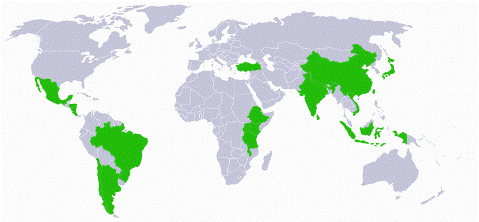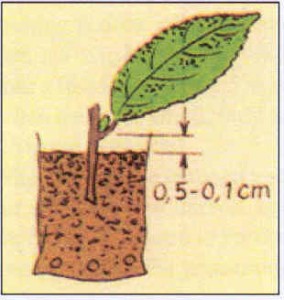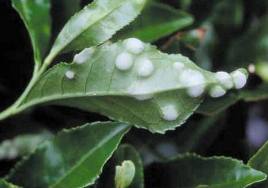Example: Natural History of Tea
This component of the Case Study assignment asks each group to create written explorations of the following disciplinary perspectives as they relate to the natural history of tea. Your text should be at least 1000 words and include a minimum of two images that illustrates your text. Maps, graphs, and charts are encouraged. Include a caption with image attribution for each visual resource. Include at least four references, fully cited, one of which can be a program text.
You may enjoy a broad historical understanding of what natural history studies are: https://en.wikipedia.org/wiki/Natural_history
For our case study of tea, at a minimum your group should focus on the tea species known botanically as Camellia sinensis. Your discussion should address at least the following topics: botanical description, native and cultivated geographic ranges, suitable climate, suitable soil properties, major pests and diseases, propagation methods, and typical cultivation and harvest practices for field grown plants.
*Note: References should be peer-reviewed journal articles when available and appropriate, then books, then websites. Link all references to your tea Zotero bibliography.
Camellia sinensis is an evergreen shrub native to East Asia, and is common through China, Tibet, and India. The common name “tea” via Dutch from the Malay word teh, predated by “t’e” from the Amoy Chinese dialect (“Online Etymology Dictionary”) and just like the name the plant and product have been widely disseminated through out the world. The plant grows between the 42nd north parallel and the 33rd southern in tropical temperatures between 60 and 80 degrees fahrenheit (~14-27 degrees celsius) and prefers elevation between 3,000 and 6,000 feet “Habitat and Geography.” . The tea plant prefers well draining gravelly soil with a pH balance of 4.5 to 7.3 (“Camellia Sinensis Tea Plant, Assam Tea, Tea Tree Camellia PFAF Plant Database.”) The consumable part of the plant is the top three leaves (alternately arranged) which are high in tannins bitter alkaloids like caffeine and theobromine, once steeped in hot water the “tea” may be drunk and the strained leaves may be cooked as a side dish.
-Lliam Carlton (Edited by Nora Hantula, Glenn Tippy)

Regions of Camellia Sinensis Cultivation
http://(http://bioweb.uwlax.edu/bio203/s2009/bell_patr/Habitat%20and%20Geography.htm)
Tea can be propagated by seed or cuttings. A good method of picking productive seeds is by putting them in water and using the ones that sink. At which point they are put into a wet material to germinate. After germination they are placed in nurseries to grow for 1-4 years. Propagation by seed aside, the use of leaf cutting to establish productive plants is a more common method. Propagators select cuttings from carefully picked plants and place them into bags filled with compacted soil, at which point they are put into shady environments to await being planted in the main field. In fields at low elevations shade trees are incorporated to help the tea plants grow, and grass is planted along with the plants in fields located on slopes to help with water retention and soil erosion.
-Glenn Tippy (Edited by Nora Hantula, Lliam Carlton)

Illustration of Tea propagation http://www.fftc.agnet.org/library.php?func=view&id=20110803134234&type_id=7
The tea growing regions in India are perfectly suited for hosting a number of different pests and diseases. Over the past decade numerous tests have been conducted on the pests and diseases that target the Camellia Sinensis plant. It’s important for farmers of tea plants to reduce plant loss that results from these pests and diseases. But overuse of pesticides and fungicides can ruin the teas and leave them unfit for the market. Pesticides are expensive and consumers are leery of the effects they on the environment as well as their bodies; such concern has lead to farmers and workers adopting more ecologically friendly and less caustic methods such as early detection, and the use of oils as a replacement to pesticides. Some of the major types of pests that affect the Camellia Sinensis plant include chewing pests such as caterpillars and worms, sucking pests such as Jassid, Thrips, and Aphids, Mite pests such as the Scarlet Mite, Pink and Purple Mite, and the Red Spider Mite. Wind, moths, cattle, weed hosts, tea pluckers, and bush to bush contact are the main causes of dispersal for these pests. Some of the most common diseases that effect Camellia Sinensis are, Camellia dieback, root rot, various blights, Algal leaf spot, and tea scale.
-Glenn Tippy (Edited by Nora Hantula, Lliam Carlton)
There is a significant amount of microbial biomass in the soils in agroforestry plots compared to monoculture plots. Camellia sinensis strives best in locations where the soil is acidic. On average, the pH value of the soil hovers around 4.5-5.5. The plants typically grow at a 6500 foot elevation, unlike coffee which grows in similar acidic soils but at lower elevations. Camellia sinensis is also typically found on sloped landscapes.
-Nora Hantula (Edited by Glenn Tippy, Lliam Carlton)
Much of the harvesting and plucking techniques of camellia sinensis provides the taste profiles to different types of tea. One quick example is the differences in oxidation and how the various percentages decide what kind of tea it is (black, gree, oolong, pu-erh). It is also evident that the amount of time that leaves are left to wither determines the sugar content. The longer they sit, the carbohydrates start turning into sugars which is beneficial for some desired tastes and are ideal for iced tea. The time of year that the plantations choose to harvest provides the grade of tea that is produced. Teas harvested in the spring or summer are known to be lower grade teas while tea harvested in the fall is the most fruitful. Tea shoots that are harvested mechanically will produce more tea quicker, but it will contract more impurities within the tea and within the plant that it came. Hand picking is the traditional method of harvest and ensures more care for product and plant. Harvesting by hand means that only the mature leaves will be taken and anything that has been sitting on the plant for too long or is still early in its maturation process will be left behind. The plants will also be more healthy because their entire crop has not been stripped from their bodies.
-Nora Hantula (Edited by Glenn Tippy, Lliam Carlton)

